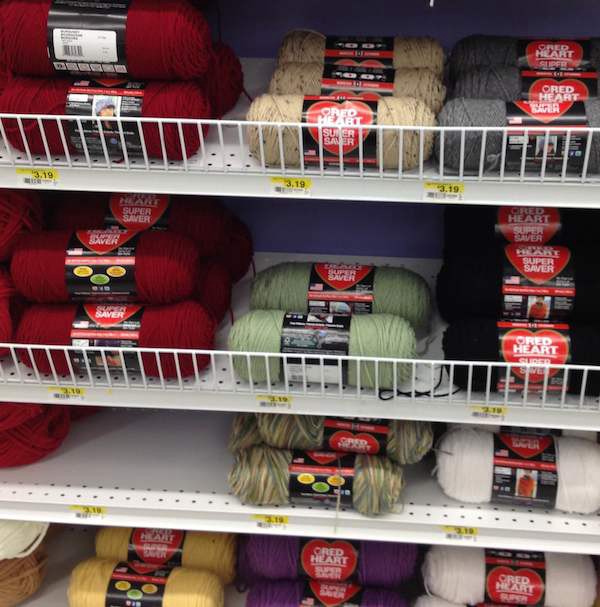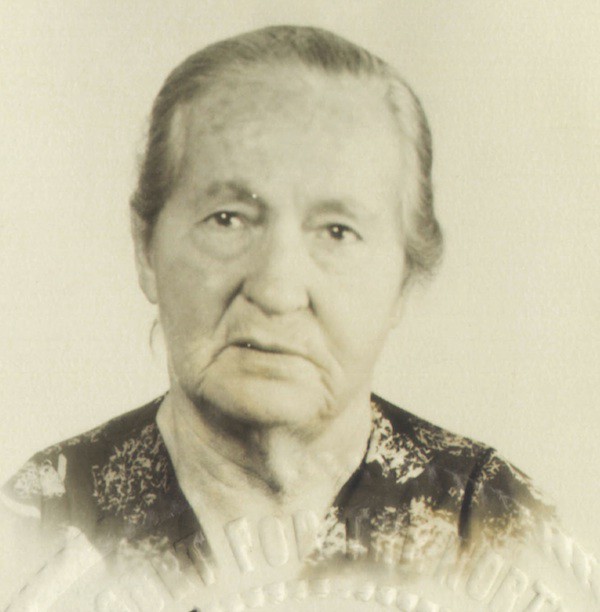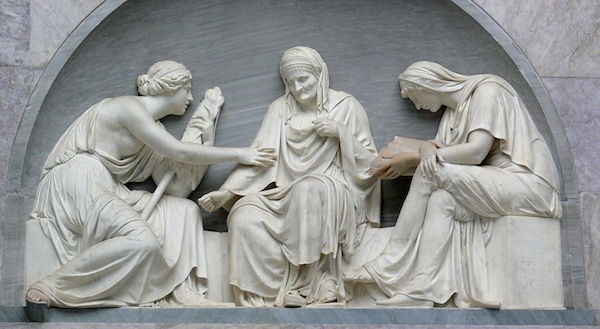Spin, Measure, Cut: Hobby Lobby and the Tangled Skein of Reproductive Rights
by Susan Schorn

I blame my compulsive crocheting habit in large part on my great-aunt. For the first 39 years of my life I shared a birthday with her: Auntie Marie was born on July 11, 1907, and I came along exactly 60 years later. Like my grandmother — her sister — Auntie Marie worked blue-collar jobs her whole life, raising a son alone after her husband died, but in spite of all the hardship she lived to the age of 99. Like all the women in my family, she was made of stern stuff.
But Auntie Marie had a soft side, evident in the packages she regularly sent to our family in Texas. She made afghans for us — one or two every year for the family, and one for each of us kids, in whatever colors we requested, at some point before we went off to college. “I’m finishing an afghan for you,” she would tell my mother on the phone, and soon a box would arrive from Chicago with a letter, a can of Poppycock, and an afghan.
“I only learned the one pattern,” my great-aunt told me once, sounding a little regretful. All of her afghans were made “corner-to-corner.” The pattern is simple, built on blocks of three double crochet stitches, stair-stepping horizontally across the surface of the afghan. Swapping in a contrasting color of yarn produces stripes.

An afghan made by the author’s great-aunt, which has been in daily use for more than 30 years. The author’s favorite colors at age 13: Green and brown.
The yarn Auntie Marie crocheted with was, by today’s standard of handcrafted boutique textiles, barbaric. Made of aggressively unnatural fiber, it had neither the pleasing springiness of wool nor the honest, cool slip of cotton. The stuff flexed like bedsprings. I learned to crochet with the same kind of yarn, and found it raw and rough to the touch. It didn’t respond nimbly to tensioning the way natural fibers do; it had to be tugged and wrestled into place. If you worked too fast or for too long, it wore grooves in your fingers. It was stern stuff, not unlike my great-aunt. But once washed and then blasted in a hot dryer, the afghans Auntie Marie made from this 110 percent acrylic yarn were soft and warm. We put them on our beds and on the chairs in the family room; we pulled them over our knees or around our shoulders when we were reading.
I still crochet afghans, and I still enjoy working with the same crappy acrylic yarn my great-aunt used. For one thing, it’s cheap, and if you were raised in a large Catholic family, you look askance at popular crochet projects that call for $120 worth of hand-dyed organic cotton yarn. (“A hundred and twenty dollars?” I can hear my great-aunt saying, none too quietly. “If I had that kind of money, I wouldn’t need an afghan. I could keep the heat set on 70.”) Also, cheap acrylic yarn is available in a gazillion colors. True, many of those colors are hideous, but that’s beside the point. It’s the range of options that counts.

“Choice.”
Shopping for yarn is the best part of any fiber arts project. You aren’t yet bogged down in pattern errors or boredom; the cats haven’t claimed your partially-completed project to sleep and barf on; no curious toddlers have pulled the knitting needles out of your work, leaving you the odious, soul-crushing task of picking up 172 dropped stitches (I also knit, but have not done so since my daughter’s toddler years). Your project is still a vision of hope and opportunity; a dream of colors and textures hovering on the verge of realization. This is why, in most yarn stores, the customers all seem to be sleepwalking, ambling along the aisles in silent contemplation of the yarns, comparing them by brand, thickness, fiber content, and color. We stand there, we yarn aficionados, glorying in the presence of so much choice. Tea Leaf or Hunter’s Green? we ask ourselves. Sportweight or worsted? The possibilities are endless.
In today’s ecosystem of handicrafts, however, working with crap yarn makes you a bottom feeder. You don’t frequent the lovely little yarn shops with their musky, lanolin-rich atmosphere and handloom weaving classes. Such shops do not acknowledge the existence of acrylic yarn. You have to buy crap yarn at places like Wal-Mart. Fabric stores like Jo-Ann’s and Hancock Fabrics carry it. And of course mass-market craft stores like Michaels and Hobby Lobby offer it in abundance.
I imagine Hobby Lobby CEO David Green would love to sell me yarn so I can make afghans like my great-aunt’s. Given that he and his family run Hobby Lobby “on Christian principles,” he’d probably be delighted at the thought of craft supplies from his store uniting the generations of my family, passing on a tradition, and propagating all the solid middle-class values that evangelical Christians seem to think they invented.
But the virtues and values my great-aunt passed down to me differ significantly from David Green’s. Which is why I don’t buy yarn at Hobby Lobby.

The author’s great-grandmother in 1957, at the age of 69. She could have taken David Green down with one slap.
My great-grandmother was illiterate. I’ve written elsewhere about her journey to America, and how she imparted to her daughters a peerless work ethic, along with an abiding mistrust of male authority figures. She learned her family values in Italy, where the Catholic church and its priests basically ran society. According to their values, she wasn’t allowed to learn to read and write like her brothers did. Instead, she stayed home and helped her mother take care of the younger children.
When my great-grandmother was a teenager, the deeply held religious beliefs of her male relatives led them to arrange her marriage to my great-grandfather who was, by all accounts, a loathsome human being. She of course immediately started having children, and after her first son died from malnutrition, her husband left her and their second child in Italy while he traveled to America. Once here, he seemed content to abandon his impoverished family back in the Old World, but my great-grandmother possessed the wherewithal to get on a ship, cross the Atlantic with her toddler son, and hunt down the protector and provider to whom the Lord, and the patriarchy, had joined her for life.
In America, my great-grandmother endured multiple pregnancies, many of which ended in miscarriage due to violence at her husband’s hands. But five of her children survived, among them my grandmother and great-aunt. What values did their mother pass on to them? For one thing, they learned that letting men control their bodies and lives was a very bad idea. They were Americans, their mother assured them; they couldn’t be forced into illiteracy, dependency, marriage, or pregnancy. Here in America, the priests didn’t make the laws, and fathers and husbands couldn’t invoke tradition to control women’s live.
My great-grandmother made sure her daughters went to school; she taught them to value education and knowledge over superstition and religious doctrine. Today, the women in my family make afghans, and some of us go to church. We also have college degrees. We have our own beliefs about procreation, but we also think critically, and we value the expertise of scientists and physicians who study pregnancy and childbirth. We trust their opinions on the subject more than we do that of priests, religious leaders, or CEOs of hobby stores. Why? Because they tell us what our bodies do, not what we must do with them. They provide information that helps us make decisions for ourselves. And that is a paramount value in my family: When it’s your body that bears the consequences, you make the decisions. All of them.
When you were raised to regard America as a refuge from ignorance and despotism — as many children and grandchildren of immigrants are — there’s something perverse about standing in the aisle at Hobby Lobby, contemplating all the varieties of yarn and what you might make of them, and realizing that, if you worked there, you’d have less control over your own healthcare, your own body, your own religious beliefs, and your own procreative decisions than you would over a stupid afghan.
David Green is seeking the United States Supreme Court’s permission to deny women (and only women) who work for him insurer-provided access to certain contraceptive methods. He wants to do this because he, David Green — who is not a physician — believes those methods might interfere with the implantation of a fertilized egg into the uterine wall of one of his employees. Such potential interference constitutes — according to David Green, who is also not a theologian — murder, because a fertilized egg is, in David Green’s deeply held religious beliefs — which are at odds with those of most medical professionals as well as many other mainstream religions — a human being.
Make no mistake: David Green and his family, the owners of Hobby Lobby, are proud of what they’re doing. They think they’re martyrs. They’ve filed a federal lawsuit and become heroes to conservatives across the country for, they say, standing up for their religious beliefs. But weigh that against the fact that while Hobby Lobby feels very strongly about contraception it might, one way or another, have to pay out money for, the company apparently can’t be bothered to lift a finger when contraception brings money into the company, either directly, through its 401K plan, or indirectly, via the cheap goods it imports from China, where government control of procreative activity often leads to forced abortions. Somehow, I find it odd that a deeply-held religious belief would have such a keen awareness of the bottom line.
Furthermore, as Amanda Marcotte has pointed out, the federal lawsuit filed by David Green and Hobby Lobby doesn’t just object to the prescription of certain contraceptives, but to “related education and counseling” for contraception — in other words, they want to forbid their female employees’ doctors from talking to them about contraceptives. David Green and his family want to control the information a doctor can communicate to a patient. They say their religion demands this; that the Bible, as they read it, tells them it’s their duty.
This is the same archaic nonsense my great-grandmother had to listen to in Italy: God demands that we keep information away from women. Really, David Green and his fellows would have made excellent 19th-century Italian priests. And in fact, it appears that’s what CEOs (and big political donors) in this country are seeking to become: a new priesthood that governs every element of our daily lives and determines our futures for us. That’s exactly what my great-grandmother thought she was escaping when she came here.
Curiously, for all the damage the Catholic church did to the women in my family, they remained attached to their faith. I consider this further testament to their strength, that they refused to let an abusive church leadership separate them from God. I’m not religious myself, but I grew up seeing how prayer helped my great-aunt and grandmother bear their considerable burdens. We prayed a rosary at my grandmother’s wake, at her request, and while my great-aunt didn’t have a funeral (she donated her body for research), I said a rosary for her too after she died, even though I had to borrow some rosary beads, and felt I was speaking a language I didn’t really understand.
But crocheting, it turns out, is a contemplative activity not unlike meditation or prayer — and when I crochet, I feel close to my great-aunt, even though she’s no longer alive. Each row of an afghan is like a bead on a rosary. There is variety, and there is repetition; together they make a pattern. In my great-aunt’s afghans, three double crochets, a slip stitch, and a chain of three creates a block, just as one Our Father, ten Hail Marys, and a Doxology make a decade when you pray the rosary. You have to focus on each stitch, one at a time, but while you’re doing that, you also imagine the larger project, the completed afghan or the soul entering Paradise, keeping it in your mind’s eye as you work. Working your way methodically along a row, you have time to reflect, to question, to listen to what your heart and your hands are saying. I have found that this kind of thought, where the mind and body are both engaged, puts you in a place where you can make good decisions. And I think that may have been one reason my great-aunt enjoyed crocheting. It’s certainly one reason I do.

The Three Fates.
Humans have recognized this connection between fiberwork and contemplation for thousands of years. Take Clotho, for example, another famous decider who worked with yarn. Youngest of the three Fates in Ancient Greek mythology, Clotho was the goddess who spun the thread of human life. Her sister Lachesis measured it, and Atropos, the third sister, cut it. The work of the sisters’ hands symbolized the work of the female body, generating, shaping, and sustaining life. Of the three Fates, Clotho had the most important job: deciding who was born, and when. Consider this: The ancient Greeks — who didn’t even acknowledge women’s legal personhood — nonetheless gave male gods no say in the question of when or if life began. That was the proper domain of the goddesses. Only women had the authority to decide such matters.
Now, in modern-day America, with its religious freedoms and Constitutional protections, such questions are decided by the Supreme Court. The current court contains three women, just as the ancient Greeks might have expected it to. Unfortunately they are outnumbered two-to-one by their six male counterparts, including Justice Antonin Scalia, a Catholic Italian-American with nine children, and Justice Samuel Alito, who is also a Catholic Italian-American, but only has two kids. (I know it’s really none of my business how many children these men have, but when you grow up Catholic and hear about the evils of birth control every Sunday during mass, it’s natural to look around the pews and count noses to see who seems to be paying attention.)
So these are the Fates who will now decide what women may choose to make or do with their bodies: Six men and three women. Their decision is expected sometime this month. And from now until then, I will be crocheting compulsively. I’ll be thinking about my great-aunt, my grandmother, and my great-grandmother. I’ll be thinking about my daughter, who is ten years old and waiting impatiently for the afghan I’m making for her. And I’ll recall another mythical yarn worker, Madame DeFarge, who haunts the pages of A Tale of Two Cities, observing, judging, and knitting the fates of her nation’s despots into a pattern that will ultimately bring about their doom.

Afghan currently in progress. Favorite colors of the author’s daughter: Purple and pink.
***How to make an afghan like my Auntie Marie’s:
– Ask your niece or nephew for their two favorite colors. Buy yarn in those colors, no matter how colorblind or aesthetically incompetent your relative happens to be.
– Use whatever hook size is recommended for the yarn you chose. Gauge isn’t too important with this pattern. Crochet the first few rows and see how it looks. If your stiches are smaller and tighter than you like, switch to a bigger hook. If they’re too loose and sloppy, switch to a smaller hook.
– With either color, chain 6.
– Row One: In the 4th chain from the hook, work a double crochet. Work a dc in each of the next two chain stitches as well.
– Row Two: Turn your little square around so you’re looking at the back of it. Chain 6.
– dc in the 4th, 5th, and 6th chain stiches from the hook, just like you did on Row One.
– If you’ve crocheted before, you’re probably expecting to work your next stitches into the tops of the dcs from Row One. But no! Instead, pivot the two squares you’ve made on the little hinge of yarn between them, so the dc you just crocheted lies across the tops of the 3 dcs in row one. Now, slip stitch into the 3-chain loop on the end of Row One.
– Chain three, and then work three double crochets into that same chain-3 loop you just slip stitched into. You’ve now produced the first “stair-step” of the pattern. Keep going:
– Row Three: Turn the work over, chain six, work three dcs in the 4th, 5th, and 6th chains. Slip stich into the chain three space on Row Two, chain three, and work your three dcs in the chain three space you slip stitched into. Keep doing that until you reach the end of the row.
That’s it. That’s the whole pattern.
– When you’re ready to add a stripe, fasten off at the end of a row and start your next row with your other color. Don’t worry too much about how wide the stripes are or how many of them you end up with. Your niece or nephew will love it no matter how it turns out.
– Follow the pattern until the afghan is the width you want, then stop increasing on one side: After turning, start your next row by chaining 1, then slip stich in the first 3 dc, chain six, work your three dcs, and so on (or, if you’re switching colors, just begin in the chain-3 space).
– When the afghan is the length you want, stop increasing on the other side. Continue in pattern until you’re down to your last three dcs, and then fasten off.
– My great-aunt usually worked a border of double-crochet shells, which are also easy. Working on the edge of the afghan, single crochet into one stitch or side of a stitch, then skip two stitches, work 3 dcs into one stitch, skip two stitches, single, and so on.
*If you don’t already crochet, and don’t have a relative who can teach you, you can learn all the basic crochet stitches here or here or here.
Previously: The Limitations of Eve Ensler’s Dance-Based Activism
Susan Schorn is the author of Smile at Strangers, and Other Lessons in the Art of Living Fearlessly; she also writes the column Bitchslap for McSweeney’s Internet Tendency.